I’ve been there, staring at a patch of dirt that was supposed to become my backyard oasis. The biggest question I faced wasn’t about the furniture or the grill, but the very foundation of the space: the patio surface.
The choice came down to two popular heavyweights: pavers and stamped concrete. I spent countless hours weighing the pros and cons, and my goal here is to share my findings with you.
This isn’t just a list of facts; it’s a real-world guide to help you choose the right surface for your home, budget, and lifestyle.
A Brief Comparison Table
| Feature | Interlocking Pavers | Stamped Concrete |
| Initial Cost | Higher ($15 – $50+ per sq. ft. installed) | Lower ($10 – $28 per sq. ft. installed) |
| Long-Term Cost | Lower (minimal maintenance, easy spot repairs) | Higher (requires regular resealing, major cost for crack repair) |
| Durability | Extremely durable; flexible system resists cracking | Prone to cracking over time from settling or freeze-thaw cycles |
| Repairs | Easy & inexpensive; replace individual cracked pavers | Difficult & expensive; patches rarely match the original color/pattern |
| Design Options | Virtually limitless; huge variety of shapes, sizes, colors, and materials | Limited to available stamp patterns and color additives; can look repetitive |
| Maintenance | Low; occasional sweeping, spot cleaning, and refilling joint sand | High; requires resealing every 2-3 years to prevent fading and wear |
| Safety | Naturally textured surface provides good traction | Can be very slippery when wet unless a non-slip additive is used |
| Weed Growth | Possible in joints if not properly maintained with polymeric sand | Not an issue as it’s a solid, continuous surface |
| Installation | Labor-intensive; requires significant base preparation | Faster installation; poured as a single slab |
My Experience With Pavers
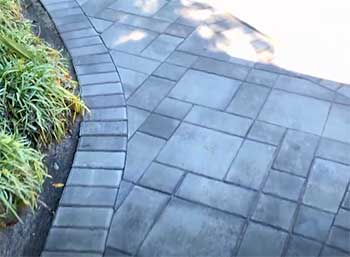
When I first started looking at pavers, I was immediately drawn to the sheer variety.
We’re not just talking about the standard red brick rectangles you see everywhere.
I found pavers made from concrete, natural stone like travertine and bluestone, and even classic clay.
They came in an array of shapes—hexagons, irregular flagstone styles, and sleek, large-format squares that looked incredibly modern. This design flexibility was a huge selling point for me.
I felt like I could create a truly unique, custom look that wouldn’t be just a copy of my neighbor’s patio.
The Upside of Choosing Pavers
The more I learned, the more I appreciated the practical advantages of a paver system.
- Durability is Their Superpower
The number one thing that sold me on pavers is how they handle the forces of nature. Each paver is an individual unit, and the gaps between them, filled with sand, create a flexible, interlocking system.
Think of it like a suit of armor versus a solid breastplate. When the ground underneath shifts, freezes, or thaws, the paver patio can move and adjust with it. This microscopic movement prevents the kind of large, ugly cracks that plague solid slabs of concrete.
The pavers themselves are manufactured under extreme pressure, making them incredibly dense and strong—often stronger than poured concrete. They can handle heavy patio furniture, fire pits, and lots of foot traffic without breaking a sweat.
- Repairs are a Breeze (Relatively Speaking)
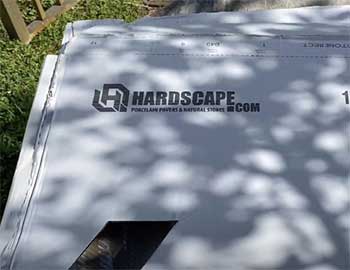
This was a massive factor in my decision. I’m a practical person, and I think about the long-term.
What happens five or ten years down the road?
If a tree root pushes up a section of the patio or I accidentally drop something heavy and chip a stone, the fix is simple.
With pavers, I can call a landscaper (or do it myself) to lift out the affected pavers, re-level the sand base underneath, and put the same pavers right back in. If one breaks, I just need to pop it out and replace it with a new one.
It’s a targeted, inexpensive fix that leaves no trace. This ability to perform “surgery” on a small section without replacing the whole thing is a huge financial and aesthetic advantage.
- Aesthetic Authenticity
There’s a certain authenticity to pavers that stamped concrete just can’t replicate. Each paver has its own texture and subtle color variations. When laid together, they create a rich, textured surface with genuine depth and shadow lines.
Whether you’re going for the old-world charm of cobblestone or the clean lines of a contemporary patio, pavers deliver an authentic look because they are the real thing, not an imitation of it.
- Permeability and Drainage
Another benefit I discovered is that traditional paver joints allow water to seep through into the ground below. This is great for managing stormwater runoff and preventing puddles from forming on the patio surface.
You can even opt for specific “permeable pavers” designed with larger gaps to maximize drainage, which is an environmentally friendly choice that can be a lifesaver in areas with heavy rainfall.
The Drawbacks of a Paver System
Of course, it wasn’t all sunshine and perfectly laid stones. I had to seriously consider the downsides before making my final call.
- The Upfront Cost Can Sting
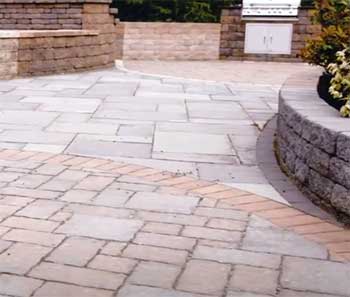
There’s no getting around it: pavers are more expensive to install than stamped concrete.
The materials themselves can be pricey, especially if you opt for premium natural stone. But the real cost comes from the labor.
Installing a paver patio correctly is a meticulous, labor-intensive process.
It involves excavating the area, laying and compacting several layers of aggregate base and sand, precisely setting each paver, and then filling the joints.
This meticulous preparation is non-negotiable for a long-lasting result, and it adds up on the final invoice. I had to weigh this higher initial investment against the potential long-term savings on repairs.
- The War on Weeds
The very joints that give pavers their flexibility can also be their biggest maintenance headache. If you use regular sand, it’s an open invitation for weeds and moss to take root. Pulling weeds from between pavers is nobody’s idea of a fun weekend.
The solution is to use polymeric sand, which is a fine sand mixed with a polymer that hardens when wet. It locks the pavers in place and forms a tough, flexible barrier that keeps most weeds out.
However, it’s not a one-and-done solution. Over time, it can break down and may need to be topped up or replaced.
- Potential for Shifting and Settling
This is the biggest fear with pavers, and it all comes down to the quality of the installation. If the base isn’t properly excavated and compacted, the pavers will shift, sink, or become uneven over time, creating tripping hazards.
This is why you can’t cut corners on installation. I realized that my paver patio would only be as good as the foundation it was built on, which meant finding a reputable installer was just as important as choosing the pavers themselves.
The Seductive Simplicity of Stamped Concrete
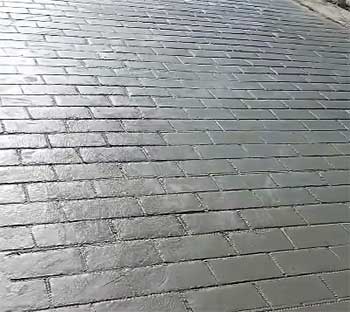
After feeling a bit of sticker shock from the paver quotes, I gave stamped concrete a very serious second look.
The appeal is obvious.
You can get the look of expensive flagstone, rustic wood planks, or classic brick for a fraction of the cost.
The process seems so efficient: pour the concrete, apply a color, press a pattern into it, and you’re done.
For a moment, it felt like a brilliant hack to get a high-end look on a more manageable budget.
Why Stamped Concrete Is So Appealing?
I can’t deny the powerful arguments in favor of going with a stamped slab.
- Budget-Friendly Beauty
The most compelling reason to choose stamped concrete is the initial cost savings. Because it’s installed as one monolithic slab, the labor is generally faster and less complex than setting individual pavers.
This translates directly to a lower price tag. For many homeowners, this is the deciding factor. It puts a decorative, patterned surface within reach for those who might otherwise have to settle for a plain, boring slab of concrete.
- A Solid, Weed-Free Surface
I loved the idea of a patio with zero cracks for weeds to sprout from. Stamped concrete offers a continuous, solid surface that is incredibly easy to sweep clean.
There are no sand-filled joints to worry about, no ants building little mounds, and no need to ever get on your hands and knees to pull out a stubborn dandelion. The low-maintenance appeal of a solid surface is very strong.
- Endless Patterns and Colors
Just like with pavers, the design options are vast. Stamping mats come in dozens of patterns that can mimic almost any material imaginable. You can have the texture of slate, the pattern of ashlar stone, or even the grain of weathered wood.
The color is typically added in two ways: a base color mixed into the concrete itself, and a secondary, darker “release agent” applied to the surface, which gives it highlights and depth, making the pattern pop. This two-tone effect is what makes it look so convincing from a distance.
The Cracks In The Facade: The Downside of Stamped Concrete
As I dug deeper, I started to see the potential long-term problems. The very nature of concrete as a material creates issues that you just don’t have with a paver system.
- The Inevitability of Cracking
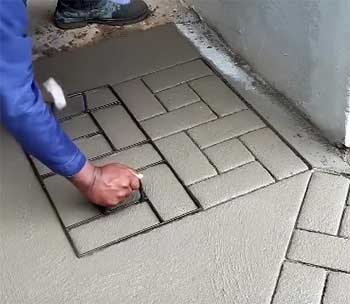
This is the elephant in the room. Concrete, by its very nature, cracks.
It’s not a matter of if, but when and where. Installers try to manage this by cutting control joints into the slab to encourage it to crack in straight, predetermined lines.
However, sometimes random, sprawling cracks—often called “spider cracks”—will appear anyway due to ground settling, heavy loads, or freeze-thaw cycles.
On a plain concrete slab, a crack is an annoyance.
On a stamped concrete patio, a crack is a catastrophe. It runs right through the beautiful pattern, completely shattering the illusion. There is no good way to hide it.
- The Nightmare of Repairs
This follows directly from the cracking issue. How do you fix a crack in stamped concrete? The answer is, you can’t, not perfectly. You can fill the crack with a concrete patching compound, but it will never match the color and texture of the original.
The patch will always be visible, looking like a scar across your patio. If a large area is damaged, you can’t just replace one section. Your only real options are to live with the ugly patch or tear out and re-pour the entire slab, which is incredibly expensive and wasteful.
This lack of repairability was a major red flag for me.
- The Maintenance Treadmill
While you don’t have to worry about weeds, stamped concrete is not a maintenance-free surface. To protect the color from fading under UV rays and to prevent surface wear and tear, it must be cleaned and resealed every 2 to 3 years.
This involves pressure washing the surface and applying a quality sealer. This is a recurring cost and a chore that you’ll be stuck with for the life of the patio.
If you neglect to seal it, the color can fade dramatically, and the surface can become pitted and worn, losing the very decorative look you paid for.
- It’s a Slippery Slope
A standard sealed concrete surface can become incredibly slippery when it’s wet. This is a serious safety concern, especially if you have kids or elderly family members.
While installers can mix a non-slip additive into the final sealer coat, it can slightly dull the finish and adds to the cost. It’s an essential add-on that you absolutely shouldn’t skip, but it’s another thing to remember and another potential point of failure.
Frequently Asked Questions (FAQ)
Neither is universally “better,” as it depends on your priorities. Pavers are better for long-term durability and repairs, offering a more authentic look but at a higher initial cost. Stamped concrete is better for achieving a decorative look on a smaller initial budget, but it’s prone to unrepairable cracking and requires more maintenance.
The main disadvantages are the higher upfront installation cost, the potential for weeds to grow in the joints (if not using polymeric sand), and the risk of pavers shifting or sinking if the base is not installed correctly.
The biggest downside is its tendency to crack over time. When it cracks, the pattern is ruined, and repairs are obvious and unsightly. It also requires regular resealing every 2-3 years to protect its color and surface, and it can be very slippery when wet without a special additive.
Initially, it is almost always cheaper to pour a stamped concrete slab than it is to properly install a paver patio. However, the long-term cost of ownership can be higher for stamped concrete due to resealing and the potential for costly replacement if it cracks badly.
My Final Verdict And What It Means For You
After weighing every angle, I ultimately chose pavers for my own project. The high upfront cost was a tough pill to swallow, but the long-term peace of mind was worth it to me.
I couldn’t get past the image of a beautiful stamped concrete pattern being ruined by an ugly, permanent crack. The ability to easily and affordably repair a paver patio felt like an insurance policy against future headaches.
I valued the authentic look and the superior durability of the flexible paver system over the lower initial price of stamped concrete.
Now, what does this mean for you? You need to look at your own situation with the same analytical eye. If your primary constraint is your initial budget and you want a decorative look, stamped concrete is a valid and attractive option.
Just go into it with your eyes open, understanding that you are signing up for regular resealing and accepting the risk of cracking down the line. Find an installer who is an expert in proper joint placement to minimize that risk.
However, if your priority is long-term performance, ease of repair, and you see this as a forever investment in your home, I believe pavers are the superior choice.
The extra money you spend upfront is buying you durability, flexibility, and the security of knowing that almost any problem can be fixed. For you, the key will be investing in a top-notch installer who will build a bulletproof base.
Ultimately, the choice between pavers and stamped concrete is a classic trade-off: lower cost and higher risk versus higher cost and long-term security. By understanding the true pros and cons of each, you can make the decision that’s right for your home, your wallet, and your peace of mind.
